Latkes and sufganiyot, fried and tasty, symbolize Hanukkah miracle
Love fried food? Meet Hanukkah, where hot oil plays a starring role, with the candelabra (menorah) and spinning tops (dreidels) as co-stars.
Two holiday dishes, potato pancakes (latkes) and doughnuts (sufganiyot), are the centerpiece of American Hanukkah celebrations. As Hanukkah 2021 begins at sundown Nov. 28 and ends the evening of Dec. 6, the oil will bubble before the Thanksgiving leftovers are gone.
Oil has a deeper meaning
Jewish people spend the eight days of Hanukkah indulging in fried foods. When the Jewish people reclaimed the holy temple more than 2,000 years ago, they searched for oil to light the menorah, said Rabbi Levi Stein, executive director of Friendship Circle, which operates the Friendship Café and Bakery, 8649 N. Port Washington Road in Fox Point.
“They found one bottle; the miracle is that oil lasted for eight days,” Stein said. “We celebrate by eating fried foods. That does not mean we advocate for unhealthy eating but if, once a year, you eat fried food, I think you’ll be OK.”
Latke tips and tricks
Latkes bring back memories for many in the Jewish community because of the taste, family connections and that signature smell that stays with you, literally and figuratively.
Grandma Klasky’s latke recipe is a popular side dish at the annual Hanukkah dinner at Amilinda, 315 E. Wisconsin Ave. This year's Hanukkah dinners will offer a slightly pared down menu on Dec. 3 and 4.
“We’ve had customers get angry when we run out,” chef-owner Gregory León said. “My grandma would stick everything in the food processor and grind it up instead of grating the potatoes, so the batter is very liquid-like. These aren’t traditional shredded latkes, but people love them.”
Latkes were a hot commodity during León’s childhood visits to his grandparents in Tulsa, Oklahoma.
“My grandfather would count how many latkes we each had, to make sure nobody was getting more than anyone else,” León recalled.
A few decades ago in Boston, Lilly Goren, now of Shorewood, threw epic Hanukkah parties while attending graduate school.
“Those Hanukkah parties were the social event of the season. I used 40 pounds of potatoes and 15 to 20 pounds of onions,” Goren recalled. “I would warn people, ‘Don’t wear a sweater, wear a sweatshirt and leave your coat in the car.' People would tell me they could smell the latkes down the street.”
Every year Goren pulls out a cookbook she created in a south side Chicago kindergarten class in the 1970s. One instruction that’s not in the book: “Before I start frying, I do the ritual disengaging of the smoke alarm,” Goren said.
At Stone Creek Coffee Downer Cafe & Kitchen, the latkes have become an occasional menu item, thanks to Gary Wolfe, whose son used to manage the cafe.
“When my son worked at that Stone Creek in college, he gave them my recipe,” Wolfe said. “It’s potatoes, flour, lots of eggs and a big onion. Mix it all together in a huge bowl.”
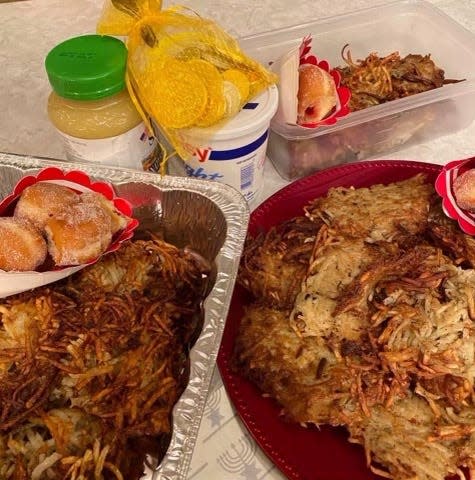
Spoiler alert: Latkes taste best when they’re freshly cooked.
“The next day they’re OK; if you wait two days, they’re terrible,” Wolfe added.
Peeling potatoes is the worst part of latke making, but Jaime Druck found a shortcut for that messy step. Druck, of Fox Point, is a real estate agent and mother who makes latkes every year.
“Get an automatic potato peeler. It’s the most amazing thing you could humanely use for this project. It’s such a game changer,” Druck said.
With freshly peeled potatoes, Druck follows a specific process with one key to success.
“Cheesecloth is the secret to getting good, crispy latkes. You get rid of all the extra moisture” by wringing out the just-grated potatoes in it, Druck said.
But there’s no way around the smell of fried food.
“The smell stays in your house and your clothes. … It smells like lots of oil and love,” Druck added.
Latkes overseas
The universal appeal of Jewish foods is reflected in memorable overseas dining.
Chef Zee Mehler, a caterer and traveling kosher chef, filled 170 duffel bags with cooking supplies and flew to Uman, Ukraine, in the fall to set up shop in a hotel kitchen. From there he prepared meals for 150 Orthodox Jewish men who were attending a massive annual pilgrimage.
“This event is like Coachella; it’s a big piece of the Uman economy,” Mehler said.
The Ukranian women helping in the kitchen taught Mehler to think outside the box.
“We did a pancake bar with traditional latkes and carrot latkes and my leek pancake that’s more Asian,” Mehler said. “We hand grated and deep fried everything. It took me forever to wash the smell of oil out of my hair.”
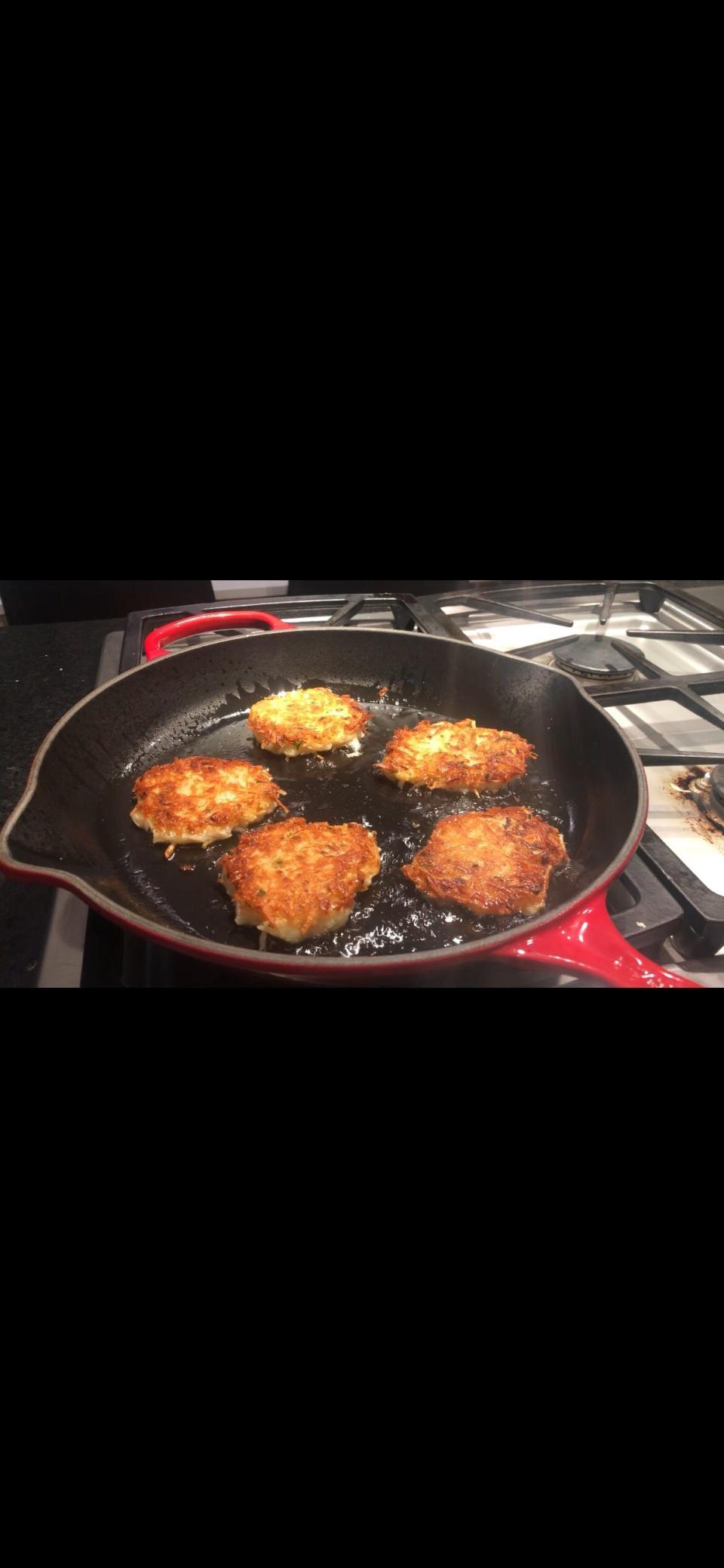
Raising two young sons in Switzerland for 10 years forced Sharon Madnek to create her own Hanukkah.
“I felt very isolated as a Jew in Switzerland; I wanted my kids to have an English Hanukkah experience,” Madnek recalled. “I found a Jewish holiday children’s book that became our Hanukkah bible. It had a recipe for ‘Malka’s Latkes.’ ”
Madnek’s sons grew up and moved to different cities, but when they visit Madnek’s Fox Point home, they request latkes.
“They would never be OK with anything but these latkes. In Switzerland, we were sharing our culture, and this latke recipe is wrapped up in that,” Madnek added.
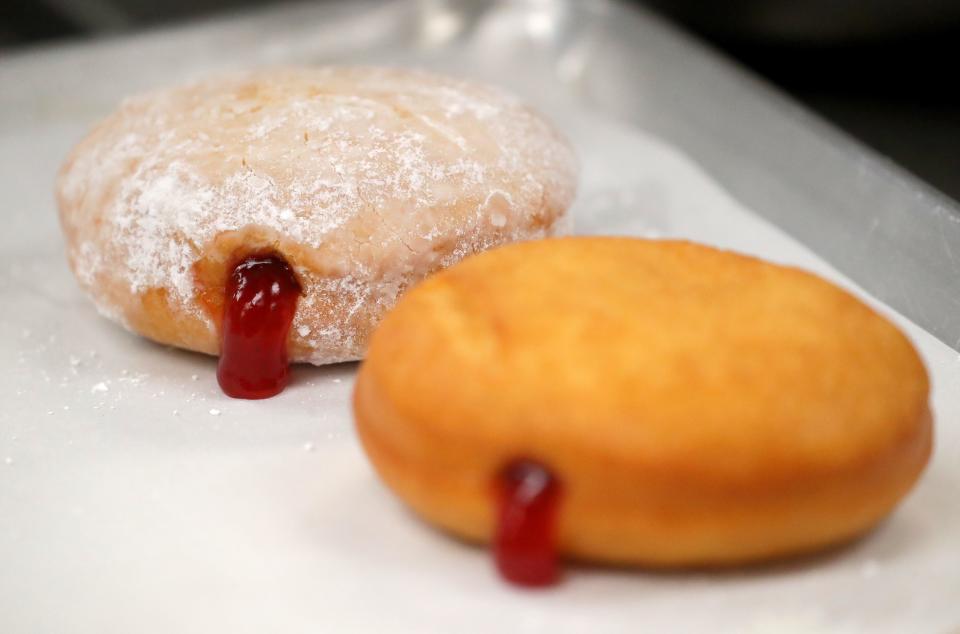
Time to make the doughnuts
At Friendship Café and Bakery in Fox Point, lighting Hanukkah candles mirrors the mission there to train and employ adults with special needs.
“The menorah has the shamash, the helper; it lights the other candles and helps grow the light,” Stein said. “That’s what our employment training program is about. Our graduates can go out into the real world and get a job … so they can shine their lights in every business in Milwaukee.”
Pastry chef Eira Terrazas’ shares the mission. Food has been a major part of Terrazas’ family since they moved to Milwaukee from Mexico 20 years ago.
“I grew up around pots full of amazing dishes, and my auntie used to own a bakery,” Terrazas said.
After graduating from MATC, Terrazas joined Friendship Bakery.
“I didn’t know anything about Jewish food, but I love these doughnuts. They’re easy and fun,” Terrazas said.
Guiding Friendship Bakery’s program participants is a highlight of the job.
“I’m surrounded by amazing people who find happiness in the smallest details. They teach me the real meaning of life every day,” Terrazas said.
“When our participants see people coming in and buying doughnuts they worked so hard to make, they’re so proud of their work. What better way to support local and make a difference in the lives of these special bakers than to come to Friendship Circle and buy a doughnut,” Stein added.
*****
Buying doughnuts and eating dinner
Order doughnuts at fcwi.org or visit the cafe, 8649 N. Port Washington Road in Fox Point, for a fresh doughnut while supplies last during Hanukkah, Nov. 28 to Dec. 6. Cafe hours are 9 a.m. to 5 p.m. Sunday, 6:30 a.m. to 5 p.m. Monday to Thursday and 6:30 a.m. to 3 p.m. Friday.
For details about Amilinda’s annual amenu inspired by Sephardic Jewish cuisine — served this year on Dec. 3 and 4 — keep an eye on the website, amilinda.com. Call the restaurant to reserve seats, (414) 369-3683.
*****
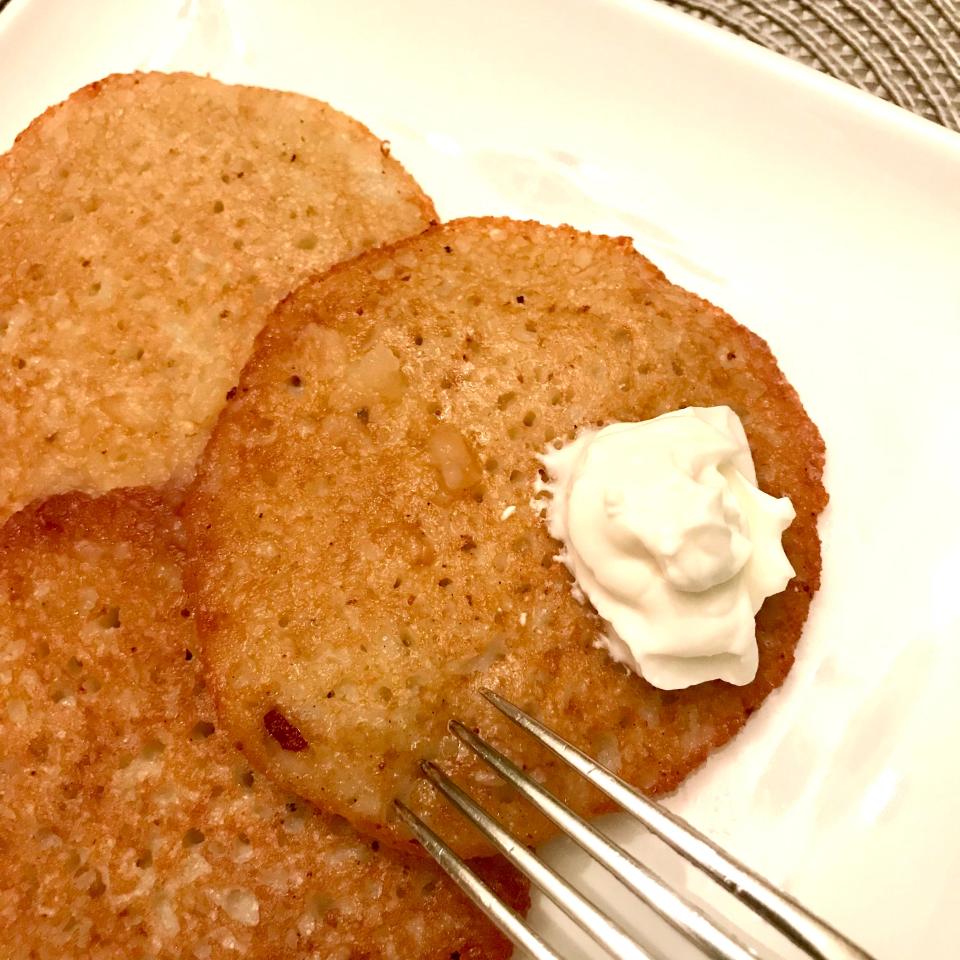
Chef Gregory León wrote this recipe to use at home and at his downtown restaurant, Amilinda. “My grandmother, like her mother, did not use a recipe, she just made them by sight,” León says.
Grandmother Klasky’s Latkes
Makes about 16 4- to 5-inch latkes
3 pounds russet potatoes, peeled and cut into small chunks of about 1 inch
1 small yellow onion, peeled and cut into small chunks
2 large eggs
5 tablespoons flour
1 teaspoon kosher salt
½ teaspoon ground black pepper
Cooking oil or shortening, for frying
Place all ingredients in the bowl of a food processor. Grind until potatoes are completely liquefied and all ingredients are mixed thoroughly.
Heat a heavy-bottomed skillet over medium heat (see note below). Add vegetable oil to a depth of ¼ inch, or melt shortening to the same depth.
When the oil is hot (you can test by adding a drop of batter to the pan to see if it sizzles), ladle a small amount (3 ounces, about ⅓ cup) of potato mixture into the skillet for each latke. Cook for approximately 2 to 3 minutes or until the edges crisp, bubbles form in the center of the pancake and the bottom is deep golden brown.
Flip latkes, taking care not to splash yourself with hot oil, and cook for another 2 minutes, or until bottom is golden brown. Remove to plate or tray lined with paper towel to absorb excess oil and place in warm oven while frying the rest of the latkes, or serve them as they're finished. Add oil to the pan as needed and let it heat before adding more batter.
Serve latkes hot with sour cream and applesauce.
Note: Alternatively, used a greased griddle to fry the latkes.
Sign up for our Dish newsletter to get food and dining news delivered to your inbox.
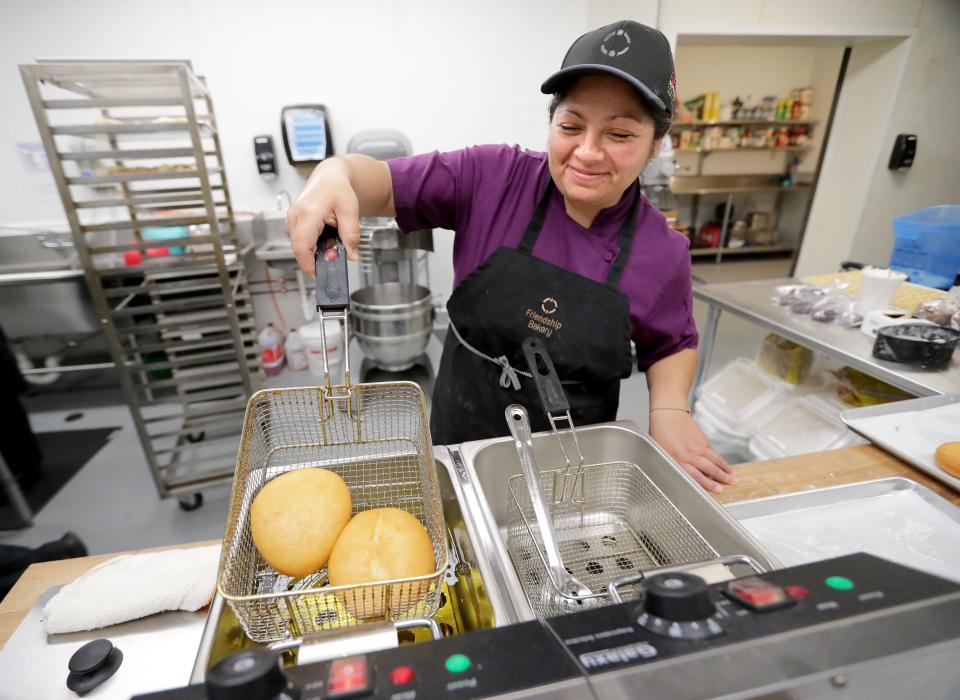
Our subscribers make this reporting possible. Please consider supporting local journalism by subscribing to the Journal Sentinel at jsonline.com/deal.
DOWNLOAD THE APP: Get the latest news, sports and more
This article originally appeared on Milwaukee Journal Sentinel: Latkes and sufganiyot, fried and tasty, symbolize Hanukkah miracle

